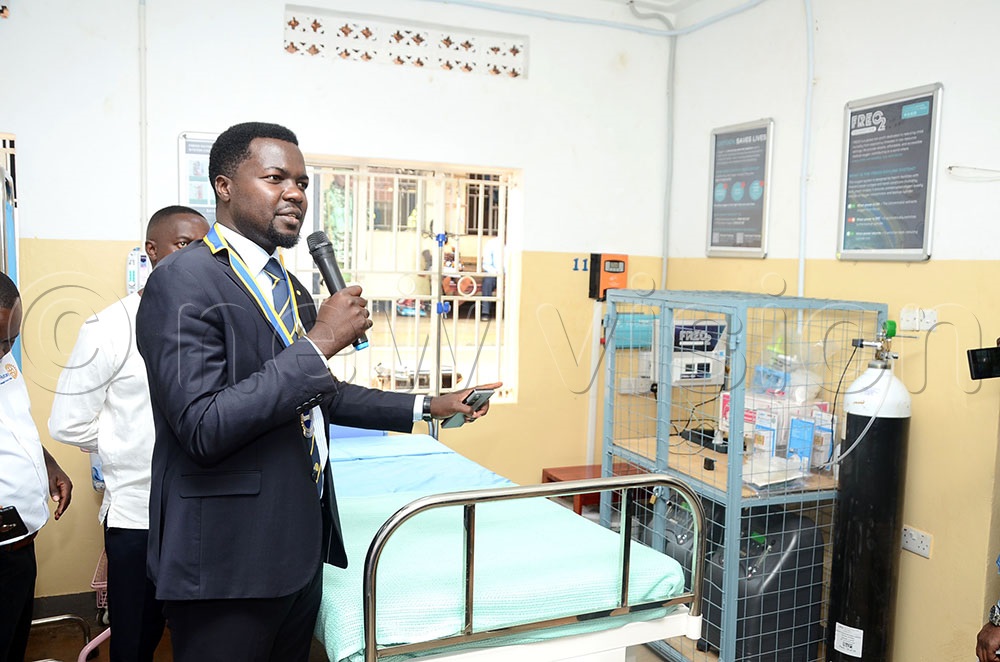Kalangala’s solar-powered neonatal ICU offers hope to newborns
For decades, the lack of specialised neonatal care meant that newborns born with birth asphyxia often faced insurmountable odds, with the nearest neonatal unit located hours away on the mainland.
Kenneth Rubango, the president of the Rotary Club of Muyenga Tank Hill and Christine Kyeyune Kawooya the District Governor for Rotary District 9214 demonstrating how some of the equipment in the new neonatal Intensive Care Unit at Kalangala Health Centre IV work as other officials look on. (Photo by Lawrence Mulondo)
___________________
On the remote islands of Kalangala, nestled in the heart of Lake Victoria, a silent crisis has long haunted expectant mothers and babies struggling to take their first breath after birth.
For decades, the lack of specialised neonatal care meant that newborns born with birth asphyxia often faced insurmountable odds, with the nearest neonatal unit located hours away on the mainland.
But now, a new dawn is breaking over Kalangala Health Centre IV.
Thanks to a collaboration between the Rotary Club of Muyenga Tank Hill, Kisugu Victoria View, Kalangala Ssese and others, the facility has received a fully equipped, solar-powered Neonatal Intensive Care Unit (NICU). This life-saving initiative is under Rotary District 9214’s flagship project, Oxygen as a Service, focused on maternal and child health.
Kenneth Rubango, the president of the Rotary Club of Muyenga Tank Hill showing part of the oxygen generation system in the new neonatal intensive care unit at Kalangala health centre IV. (Photo by Lawrence Mulondo)
The new sh50m ICU comes fitted with vital medical tools, including a solar-powered oxygen generation system, advanced patient monitoring devices, breathing support machines known as SIPAPs, baby warmers, specialised beds and baby cots.
Dr Frank Kisakye, the in-charge at Kalangala Health Centre IV, emotionally described the dire need for such a unit.
“Of every 100 babies we receive or deliver here, around 10 to 15 are born with birth asphyxia. Without specialised equipment, our only option was to stabilise them using basic methods like normal saline and rush them to Masaka Regional Referral Hospital, a journey that many didn’t survive,” he said.
With over 75% of these babies dying during transfer due to distance and delayed care, the odds were heartbreaking.
“We’ve lost too many. This unit is a game-changer. Every mother deserves to walk into a health facility, give birth safely, and walk out with a healthy, breathing baby,” Dr Kisakye added.
What causes birth asphyxia?
Birth asphyxia occurs when a baby does not receive enough oxygen before, during, or just after birth.
Dr Kisakye explained that this often stems from prolonged labour, preterm birth, or neonatal sepsis, a dangerous bloodstream infection.
If not managed immediately, the condition can result in severe complications, including cerebral palsy and even death.
Previously, mothers and their babies shared the same ward due to limited space and equipment.
Now, with the new unit, babies will receive immediate specialised attention in a dedicated environment designed just for them.
A vision rooted in compassion and sustainability
The idea behind the NICU is not just to save lives today but to create a sustainable, long-term solution for generations to come.
Kenneth Rubango, president of the Rotary Club of Muyenga Tank Hill, emphasised the sustainability of the project.
“This NICU was built with the future in mind. The oxygen generation system, powered by solar energy, ensures uninterrupted oxygen supply. In the rare case of a power failure, the system automatically switches to backup cylinders.”
The oxygen system pulls in ambient air, filters out impurities, and produces 93% pure medical oxygen, enough to support up to ten babies and two mothers at once.
All equipment maintenance and repairs are guaranteed free of charge for life, thanks to partnerships with Joint Medical Store and the FREO2 Foundation.
Rubango added, “This project was born out of necessity. We realised that 75% of babies referred from Kalangala were dying before reaching Masaka. We had to bring the care closer to home.”
Dr Rose Tumusiime, a medical officer at the facility, highlighted the emotional toll of watching newborns struggle, and sometimes fail, to breathe.
“A baby needs to cry within the first minute of life. When they don’t, we know we’re in trouble. Every month, we see at least 10 to 15 such cases,” she shared.
Now, with the new ICU, her team can intervene in those critical moments with the right tools at hand.
“This isn’t just equipment. It’s a chance at life for our babies, the future citizens of this country,” she said.
Rotary’s broader vision
Christine Kyeyune Kawooya, Rotary District 9214 Governor, chose maternal and child health as her flagship cause.
“We realised that while we had made efforts in transport and staffing, we hadn’t addressed the gap in newborn care. That’s how the idea for neonatal ICUs was born,” she said.
Kawooya called on Rotary clubs to grow in strength and numbers, urging them to attract decision-makers who can support such critical community projects.
“When we come together in partnerships, we can achieve much more, and do it efficiently,” she said.
Kalangala resident district commissioner Fred Badda thanked Rotary for stepping in where resources were scarce.
“Children are the future. They deserve access to the same quality health services as adults. This facility is a blessing.”
Chief administrative officer Richard Tebandeke pledged the district’s support to maintain the unit and ensure it meets its full potential.
“This isn’t just a donation. It’s a responsibility we are taking seriously,” he said.
For the people of Kalangala, this neonatal ICU is more than a room with machines – it is a symbol of hope, hope that every baby, regardless of where they are born, gets a fair start at life.
As the sun sets over the Lake Victoria waters surrounding Kalangala, a brighter future rises one breath at a time.